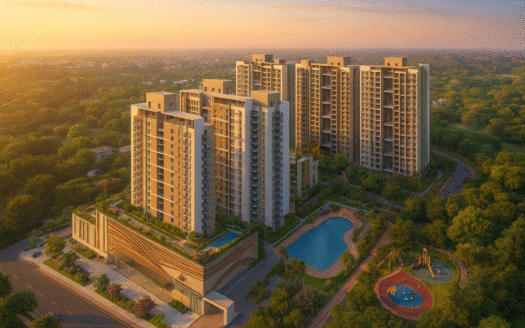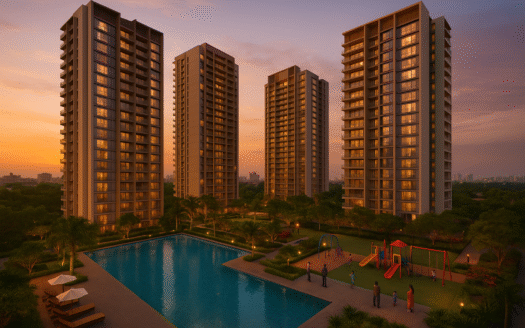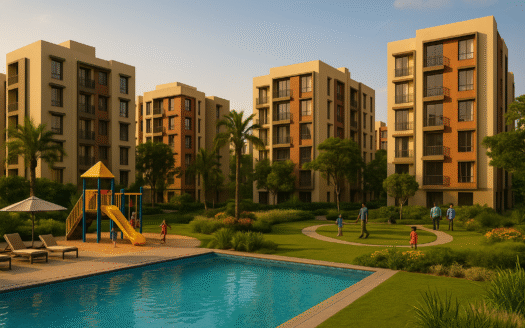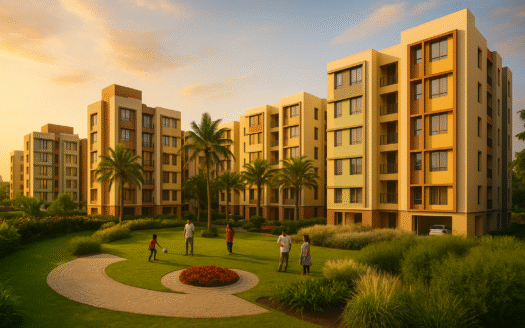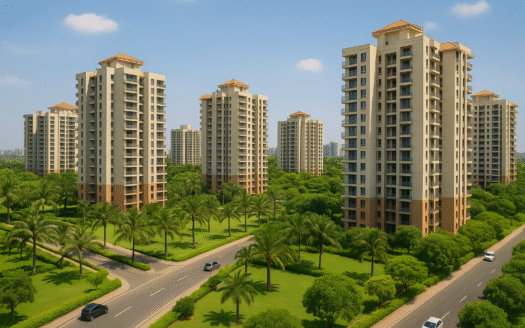Why Pune is Becoming the Next Real Estate Hotspot
Why Pune is Becoming the Next Real Estate Hotspot is Important for Buyers & Investors
Pune has quietly evolved from a charming university city to one of India’s most dynamic economic centres, pairing career opportunities with superior liveability. For homebuyers and investors, this shift is more than a headline. It directly affects entry prices, rental yields, and long-term appreciation prospects. With thriving IT and manufacturing corridors, a maturing start up ecosystem, and robust infrastructure upgrades, the Pune property market is demonstrating resilience across cycles. Families are attracted by top ranked schools, reputed hospitals and green neighbourhoods. Professionals prefer short commutes to Hinjewadi, Kharadi and Baner. Investors see a balanced market with steady absorption, improving amenities and a diversified tenant base that includes IT professionals, students and senior leadership relocating from other metros.
This guide explains why Pune is on the cusp of its next growth leap, how to select the right micro market, and what financial tools can make ownership smoother. We translate market shifts into practical decisions, such as choosing between under construction and ready to move options, or balancing a central location with a larger home in emerging hubs. Whether you are an end user seeking lifestyle stability or an investor targeting rental cash flows, Pune offers a rare combination of affordability relative to Mumbai, quality of life, and job led demand that supports price growth. Use this playbook to shortlist localities, compare budgets, and execute your purchase with confidence through a structured approach. When you are ready, Get My Ghar can help you refine choices, negotiate smarter, and complete due diligence so your Pune property works for your life and your portfolio.
Key Takeaways on Why Pune is Becoming the Next Real Estate Hotspot: What You Will Learn from This Guide
- Legal and regulatory clarity
Understand registration, RERA compliance, and documents you must verify before booking in Pune and PCMC. - Investment opportunities
Identify micro markets offering attractive entry prices, stable demand from IT and manufacturing, and potential for appreciation. - Practical buying steps
Learn how to compare projects, calculate the total cost of ownership, and plan EMIs that fit your cash flow. - Location-led advantages
Shortlist Pune neighbourhoods by commute time, social infrastructure, and lifestyle fit to maximise both comfort and returns.
Economic Drivers and the Job Market: The Foundation of Pune’s Property Demand
Pune’s real estate strength is anchored in its broad-based economy. The city hosts multiple IT parks across Hinjewadi, Kharadi, Magarpatta and Yerawada that draw talent from across India. Large global firms and domestic leaders operate campuses here, creating a dense ecosystem of high-paying jobs and regular hiring cycles that support a healthy rental and purchase market. Beyond IT, Pune’s strong manufacturing base in Chakan, Talegaon and Ranjangaon underpins steady blue and white collar housing demand. Automotive, engineering, electronics and emerging green tech occupiers diversify the tenant pool, balancing cyclicality typically seen in single sector cities.
The education network is another durable pillar. Pune’s universities and professional colleges attract students who evolve into long term city residents, driving demand for shared rentals and starter homes. This steady inflow of young professionals sustains absorption in compact one and two bedroom configurations, especially near metro routes and employment hubs. Healthcare has matured similarly, with multi speciality hospitals enabling families and senior citizens to consider peripheral yet well connected micro markets without compromising on medical access.
These economic layers translate into two tangible benefits for buyers and investors. First, vacancy risk is generally lower in locations with multi-sector employment. Second, end-user demand supports price stability across cycles, which can lead to compounding capital appreciation over longer holding periods. When you shortlist projects in Pune, look for proximity to a diverse job catchment rather than a single campus. This simple filter often improves both rental velocity and resale liquidity, making your asset more resilient in changing markets. For those relocating from Mumbai, Pune offers larger homes for the same budget and relatively shorter commutes, while preserving strong career prospects.
Infrastructure and Connectivity: The Projects Reshaping Access and Liveability
Infrastructure investment has transformed how Punekars commute and spend leisure time. The Pune Metro is expanding step by step, connecting key residential pockets with IT and commercial districts. As stations go live along important corridors, neighbourhoods within a short walk or quick feeder ride often experience rising interest from renters and buyers who prefer predictable travel times. The Mumbai Pune Expressway and the old highway together ensure intercity mobility for businesses and weekend travel, while the Pune Nashik and Pune Ahmednagar corridors enhance regional connectivity for logistics and manufacturing.
Within the city, arterial roads linking Wakad, Baner, Balewadi and Aundh to Hinjewadi, as well as the Kharadi Keshav Nagar Mundhwa belt to the IT cluster, continue to see upgrades in carriageways, flyovers and junction design. Peripheral ring road plans and improved bridges across the Mula Mutha are set to ease cross city movement further. Social infrastructure keeps pace, with reputed schools, clinics, malls and F&B high streets consolidating around modern townships and mixed use destinations. Such clusters create a walk to everything lifestyle that is increasingly sought by families and professionals who prefer reducing reliance on long commutes.
For investors, infrastructure is more than convenience. It is a leading indicator of value creation. Target micro markets where a combination of metro access, arterial road improvements and large scale commercial leasing is visible. In practical terms, this often includes sectors of Hinjewadi Phase I to III with improved last mile connectivity, the Kharadi World Trade Centre surroundings, Viman Nagar to Kalyani Nagar linkages, and Baner Balewadi with its sports and leisure ecosystem. In PCMC, Pimpri, Nigdi and Moshi benefit from industrial employment and growing retail streets. Each of these pockets blends job access with lifestyle options, a proven formula for sustained real estate absorption. Before you book, map your daily routes from the project site during peak hours. Five to ten minutes saved each way, multiplied over years, becomes a decisive edge for both liveability and rental competitiveness.
Price Trends and Micro Markets: Where Value and Growth Align
Pune offers a layered price map, allowing first time buyers, upgraders and investors to find options aligned to budget and goals. Prime neighbourhoods such as Koregaon Park, Kalyani Nagar and parts of Aundh command premium pricing due to their centrality, upscale retail and limited new supply. Growth hubs like Baner, Balewadi, Wakad, Hinjewadi, Kharadi and Hadapsar provide a mid to upper mid range spectrum with strong end user interest and healthy rental demand. Emerging corridors, including Tathawade, Ravet, Punawale, Moshi, Charholi, Wagholi and Keshav Nagar, present attractive entry points for buyers who value newer townships, better planning and improved access.
Investors should balance current affordability with future catalysts. For example, a two bedroom in an established hub may be costlier today yet offer immediate rental velocity. A similar budget in an emerging locality could secure a larger configuration with amenities, banking on infrastructure upgrades for appreciation. The sweet spot often lies in micro markets with active commercial leasing, credible developers, improving civic services and measurable commute advantages. Always compare like for like: floor, view, amenity density, parking, and possession timeline can meaningfully tilt the value equation.
Below is an illustrative snapshot that helps shortlist micro markets by average ticket size and investment potential. Use it as a starting point and refine with project specific data.
| Micro Market | Typical 2 BHK Ticket Size (₹) | Rental Yield Range | Key Demand Drivers |
| Baner and Balewadi | 85 lakh to 1.3 crore | 3.0 to 3.8 percent | Proximity to Hinjewadi, strong social infra, sports district |
| Wakad and Tathawade | 75 lakh to 1.1 crore | 3.2 to 4.0 percent | Expressway access, schools, and growing retail high streets |
| Hinjewadi Ph I III | 70 lakh to 1.05 crore | 3.5 to 4.5 percent | IT parks, rental depth, township ecosystems |
| Kharadi and Keshav Nagar | 95 lakh to 1.5 crore | 3.0 to 3.8 percent | IT SEZs, WTC cluster, riverfront improvements |
| Hadapsar and Magarpatta | 90 lakh to 1.4 crore | 3.0 to 3.6 percent | Office parks, established amenities, and schools |
| PCMC Moshi Ravet Punawale | 60 lakh to 95 lakh | 3.2 to 4.2 percent | Industrial employment, metro reach, and new townships |
Figures are indicative for guidance. Actual values vary by project specification, floor, view, possession, and developer track record. Before booking, review recent transactions in the same society or adjoining projects, check current rental listings, and compute net yield after society charges, property tax and maintenance. If you plan to buy under construction, assess cash flow timing and milestone linked payments. End users prioritising lifestyle may accept slightly lower yields for superior community living. Investors focused on returns may prefer efficient layouts in rental-friendly towers near transit and offices. Get My Ghar can help you match your objective with the right micro market so you do not overpay for attributes that do not serve your plan.
Financial Planning and Payment Options: Turning Intent into Ownership
A clear financial plan converts a good decision into a successful purchase. Begin by estimating your all-inclusive cost, which includes base price, floor rise, view premiums, parking, GST where applicable, stamp duty and registration, society formation, clubhouse charges, and advance maintenance. Account for furnishing and moving expenses if you plan to rent quickly. Next, align your down payment and loan eligibility. Salaried buyers can generally target an EMI that does not exceed 35 to 40 percent of their net monthly income. Self-employed buyers should build a slightly larger down payment buffer to manage business cash flow variability.
Choose between ready to move and under construction based on your cash flow and urgency. Ready to move properties, save on interim ren,t but may demand a higher ticket size. Under construction properties can offer staggered payments and launch stage pricing, but require discipline to manage rent plus pre EMI during the build period. Home loan options include fixed, floating and hybrid rates. A modest prepayment plan every year can cut both tenure and interest outgo meaningfully. If you are upgrading, evaluate bridging finance or a sell first, buy next strategy to avoid stress. For NRI buyers, ensure your documentation, NRE or NRO accounts and power of attorney are arranged early to keep the transaction smooth.
Use the sample table below to structure your budget for a 2 BHK purchase. Replace the figures with your project’s actuals.
| Component | Illustration for 90 lakh Property (₹) | Notes |
| Agreement Value | 90,00,000 | Base plus floors and view premiums |
| Stamp Duty and Registration | 5,40,000 to 6,30,000 | State dependent, budget 6 to 7 percent combined |
| Parking and Clubhouse | 2,00,000 to 3,50,000 | Varies by project and slot type |
| Advance Maintenance | 60,000 to 1,20,000 | Usually 6 to 12 months upfront |
| Total On Road Cost | 98,00,000 to 1,01,00,000 | Add furnishing as needed |
| Down Payment (20 percent) | ~19,60,000 to 20,20,000 | A higher down payment reduces EMI |
| Loan Amount | ~78,40,000 to 80,80,000 | Subject to eligibility |
| EMI at 9 percent for 20 years | ~70,500 to 72,500 per month | Indicative only |
Before signing, verify the title, approved plans, commencement certificates, RERA registration and possession timeline. Read the draft agreement for penalty clauses, carpet area definitions and maintenance liabilities. Track the developer’s handover history and quality benchmarks. Finally, compare at least three banks for rate, processing fee, prepayment norms and customer service. Get My Ghar can coordinate site visits, legal checks and bank tie ups so you close confidently and on time.
How Pune’s Real Estate Momentum Helped Buyers in Real Life
When Neha Deshmukh, 34, a data analyst from Nagpur, secured a transfer to an IT firm in Kharadi, she wanted a home that cut her commute yet supported long term value. Initially, she shortlisted a compact two bedroom in a central area, but parking constraints and older building services concerned her. Through Get My Ghar, she toured projects across Kharadi and Keshav Nagar, then compared travel time during peak hours. A modern township five minutes from her office consistently saved twenty minutes each way versus the central option. The community had a supermarket, clinic and co working lounge inside the campus, giving her daily convenience.
Financially, Neha used a step up home loan that matched her rising salary trajectory. She kept EMIs comfortable for the first two years and scheduled part prepayments from expected annual bonuses. Get My Ghar’s legal partner verified the RERA registration and stage-wise approvals, while our loan desk negotiated a processing fee waiver with a leading bank. Neha moved in two months after possession and listed a spare parking slot for rent to offset maintenance charges. One year later, her society’s occupancy reached critical mass, retail in the precinct opened, and rentals for similar units firmed up. Neha’s net yield improved even as her daily life became simpler. The decision to prioritise micro market dynamics, commute efficiency and future amenities paid off without stretching her budget or lifestyle.
FAQs on Why Pune is Becoming the Next Real Estate Hotspot
Which are the best areas in Pune for end users who want short commutes to IT hubs?
Baner, Balewadi, Wakad and Tathawade suit Hinjewadi professionals, while Kharadi, Keshav Nagar and parts of Viman Nagar work well for those employed in Kharadi and Yerawada.
Is Pune’s rental market strong enough to support investment purchases?
Yes. The tenant base spans IT professionals, students and mid-management across manufacturing and services. Well-located two-bedroom homes typically see steady demand, especially near metro routes and office clusters.
What legal checks should I complete before booking a flat in Pune or PCMC?
Verify the project’s RERA registration, sanctioned plans, title search, commencement and occupation certificates as applicable, and confirm agreement terms on carpet area, possession date and penalties.
How do I compare under construction versus ready to move options in Pune?
Ready to move saves on interim rent and removes construction risk, but usually costs more. Under construction can offer staged payments and launch pricing. Match the choice to your cash flow and risk appetite.
What is the typical stamp duty and registration outlay I should budget for in Pune?
Budget a combined 6 to 7 percent of the agreement value for stamp duty and registration. Confirm the current rate and any local surcharges at the time of purchase.
Do NRIs face any restrictions when buying residential property in Pune?
NRIs can buy most residential properties in India. Ensure compliant funding via NRE or NRO accounts, retain transaction records, and set up a trusted power of attorney if you cannot be present for registration.
Will the upcoming infrastructure materially influence prices in my chosen micro market?
Infrastructure typically improves liveability and buyer interest. Homes near operational metro stations and improved arterial links often enjoy better absorption and rental velocity over time.
Pro Tip on Why Pune is Becoming the Next Real Estate Hotspot
Shortlist with a two-lens model. Lens one is daily life: commute minutes door to door, school and hospital access within twenty minutes, and walkability to essentials. Lens two is investment resilience: RERA compliant developer with on time delivery history, visible commercial leasing nearby, and upcoming public infrastructure within a realistic timeline. If a project satisfies both lenses, you usually gain a smoother living experience and stronger exit options. To refine this further, inspect a delivered tower by the same developer for finishing quality and resident feedback. A thirty-minute reality check can be worth lakhs saved in rework and years saved in possession delays. Get My Ghar can structure these comparisons so your Pune decision is driven by numbers and facts, not by glossy brochures.
Conclusion & Next Steps: How to Act on Why Pune is Becoming the Next Real Estate Hotspot Today
Pune’s property momentum rests on real economic depth, improving connectivity and a lifestyle that attracts long term residents. For buyers and investors, this means access to varied budgets, stable rental demand and credible appreciation prospects across multiple corridors. Your next steps are simple. Define your objective, shortlist three micro markets that match your commute and budget, and compare at least five projects for layout efficiency, possession timeline and total cost. Conduct legal checks and secure the best loan terms before you book. When you want structured guidance, curated site visits and negotiation support, connect with Get My Ghar. We will help you translate Pune’s promise into a home or investment that works beautifully for your life and your finances.



